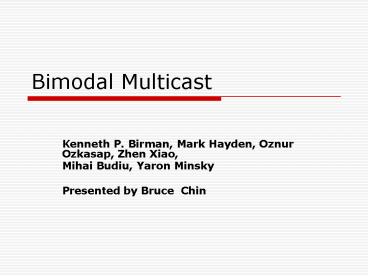Bimodal Multicast - PowerPoint PPT Presentation
1 / 20
Title:
Bimodal Multicast
Description:
... crash during ... half get the multicast but crash failures might 'conceal' outcome ... Stock market updates. Air-traffic control. Medical ... – PowerPoint PPT presentation
Number of Views:89
Avg rating:5.0/5.0
Title: Bimodal Multicast
1
Bimodal Multicast
- Kenneth P. Birman, Mark Hayden, Oznur Ozkasap,
Zhen Xiao, - Mihai Budiu, Yaron Minsky
- Presented by Bruce Chin
2
Reliable Multicast
- Strong. Provide atomicity (all or none delivery),
virtual synchrony, security, real-time
guarantees. The downside is unpredictable
performance under stress and limited scalability. - Best effort. Offers better scalability but
degrades guarantees for delivery. - This paper presents bimodal multicast or
probabilistic multicast (pbcast). Said to provide
both scalability and predictable reliability.
3
Throughput Stability
- Needed for critical real-time applications
- Perturbations occur when participants are busy.
Buffer space begins to fill up and messages have
to be delayed.
4
Throughput Stability
5
Bimodal Multicast Features
- Atomicity - "almost all or almost none" instead
of "all or nothing" - Throughput stability - can tolerate some amount
of perturbation - Ordering - FIFO order on a per-sender basis
- Multicast stability - when a message is detected
to satisfy the bimodal delivery guarantee, it can
be garbage collected - Detection of lost messages
- Scalability - costs are constant or grow slowly
6
Execution Environment
- Built on Ensemble platform
- Time is divided into execution periods in which
group membership is static - Period switching done when multicast is stable
7
Fault Model
- Percentage (75 e.g.) of messages are reliably
sent. Errors are iid. - Known, bounded delays
- Hard failures. Crashes and network partitions
- Soft failures. Failure to receive because of
transient network conditions - No handling of Byzantine failures
8
Pbcast Protocol, 2 Protocols in 1
- An unreliable, hierarchical broadcast (optimistic
dissemination protocol) multicast or spanning
tree broadcast. The choice of multicast protocol
depends on the network (LAN or WAN) and the
scalability required. - 2-phase anti-entropy. Problems are detected and
corrected by rounds of gossiping.
9
Example
- Q fails to receive M0, S fails to receive M1
- Recovered in anti-entropy phase
- Multicast and recovery rounds are concurrent, not
as shown in figure
10
Anti-Entropy Phase
- Members randomly choose a recovery partner and
say I just received these messages. (Send a
digest of messages received.)b - The recovery partner then will solicit any
messages that it missed. - To support real-time services, old messages are
eventually lost if they cant be delivered. - What about out-of-order delivery? How do you know
that you can deliver a message?
11
Issues
- Are slow processes always going to fall behind
and slow down other processes? - What if a processes is bombarded with
solicitations? - How do you limit the costs of buffering?
(Scalability) - Random gossip through a router can be a
bottleneck
12
Optimizations
- Soft failure detection retransmission requests
handled only if received in the same round it was
delivered - Round retransmission limit
- Cyclic retransmissions avoids redundant
retransmissions from previous rounds - Most-recent-first retransmission
- Independent numbering of rounds no need to
synchronize rounds among processes - Random graphs for scalability full connectivity
not needed - Multicast for some retransmissions when
multiple requests come in for the same packet,
just multicast it
13
Hierarchical Gossiping
- Weight gossip so that probability of gossip to a
remote cluster is smaller - Can adjust weight to have constant load on router
- Now propagation delays rise but just increase
rate of gossip to compensate
From Birman Lecture Slides
14
Hierarchical Gossiping
Latency to delivery (ms)
Load on WAN link (msgs/sec)
From Birman Lecture Slides
15
Computational Results
- Initial transfer unsuccessful. 5 messages lost.
0.1 of processes crash during a run - Predicate I More than 10 but less than 90 of
the processes get the multicast - Predicate II Roughly half get the multicast but
crash failures might conceal outcome
16
Experimental Results
17
Experimental Results
18
Experimental Results
19
Conclusions
- Reliable multicast schemes typically fall into
two camps - Strong guarantees on delivery but throughput is
not stable and is not scalable. - Best-effort gives better throughput but at the
cost of delivery guarantees - pbcast good for applications that can tolerate
some degree of lost information and a weakening
of the atomic guarantee - Streaming multimedia
- Stock market updates
- Air-traffic control
- Medical telemetry
20
Discussion
- What are the overhead costs associated with this
protocol? - How to handle multi-group multicasts?
- Could this be made to handle Byzantine failures?































